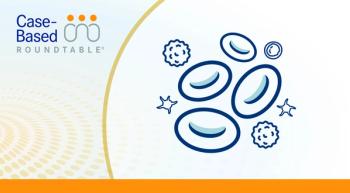
BPDCN: Key Markers and Multidisciplinary Approach
A review of diagnostic challenges and comprehensive workup, including CD markers, cytogenetics, and next-generation sequencing, for patients with blastic plasmacytoid dendritic cell neoplasm, a rare and unique acute leukemia.
Episodes in this series

Transcript:
James M. Foran, MD: I think an important question is, what is a BPDCN [blastic plasmacytoid dendritic cell neoplasm], and how do you diagnose a BPDCN? What is the workup for a patient like this? I remember, as a fellow, being told we were getting an admission on a Friday night of a patient with an NK-cell leukemia, and everybody shuddered a little bit. That’s a leukemia that was known to have a very poor prognosis. In the past, there were different terms for BPDCN, one of those being NK-cell leukemia. It’s now recognized as a unique entity, a blastic plasmacytoid dendritic cell neoplasm.
It is an acute leukemia with both myeloid and lymphoid features or markers that often has extramedullary manifestations. More than half of patients will have cutaneous involvement, extramedullary involvement, lymphadenopathy. A significant minority will have [central nervous system] involvement at diagnosis. It frequently presents through dermatology, as in this case, where a patient will come in with cutaneous masses, cutaneous nodules, or lymphadenopathy, classically a black eschar associated with it. So, this does require a multidisciplinary approach.
We routinely involve our dermatologists and dermatopathologists in these BPDCNs. It’s a rare diagnosis, but it’s important to suspect it, because it does take that team. It’s important when you’re evaluating the patient not just to work them up for acute leukemia with peripheral blood and bone marrow and flow cytometry. You do have to get cytogenetics. We know that cytogenetics are frequently abnormal. In this case, they were normal. But over half of them will have complex cytogenetics. And even though there’s no classic pattern of cytogenetic abnormalities, you can see certain patterns like MIB or MIC upregulation.
It’s also important that you perform next-generation sequencing. There’s no particular pattern, but you will often see abnormalities in TET2 or ASXL1 or RAS, or TP53 in this group of patients. We’ve had patients come in who present with lymphadenopathy and lymph node biopsy, with cutaneous masses or nodules, and a skin biopsy. We will typically request a whole-body PET-CT scan in that situation so that we have full staging of the extramedullary sites of disease.
In the past, because you can have some expression of some myeloid or lymphoid markers and based on the morphology of the blast, it has been misdiagnosed or considered as [acute] lymphoblastic leukemia [ALL] or a [acute] myeloid leukemia [AML]. Even the treatments in the past have often derived from the AML or ALL literature. For that reason, it’s important to suspect BPDCN. These are rare diseases, less than 0.5% of hematologic malignancies, with an estimate of less than 1000 cases a year in the United States. So, we know these are rare. But because we have targeted therapies that are now FDA approved for this group of patients, it’s important to consider it.
As part of our North American consortium, published by Naveen Pemmaraju, [MD, at the University of Texas MD Anderson Cancer Center in Houston,] a couple of years ago, one of the things we recommended was to think one, two, three, four, five, six. These patients all overexpress CD123, the IL3 receptor. So, CD123, CD4 expression, CD56 expression: one, two, three, four, five, six. You will also have some other markers like TCL1, as in this case. And that requires collaboration with hematopathology.
I’ve had patients where we thought it could be a BPDCN because of the CD123 expression, and we’d ask our pathologist to look at it. Alternatively, we would ask our pathologist to add CD123 when we didn’t have that routinely on our panel, if the patient had the clinical scenario where we suspected it. So, it’s important to suspect a BPDCN, to consider the immunohistochemistry and flow markers of CD123, CD4, and CD56, in addition to a bone marrow biopsy to perform cytogenetics and next-generation sequencing.
That’s really routine now in acute leukemia patients, and this is a version of that. It’s a unique entity in that area. To consider and really recommend CSF [cerebrospinal fluid] sampling and CSF prophylaxis in this group of patients and to look for other extramedullary sites of disease like lymph nodes and cutaneous involvement, and to consider this in patients who don’t have a classical phenotype of ALL or AML with these other markers.
Transcript is AI-generated and edited for readability.










































